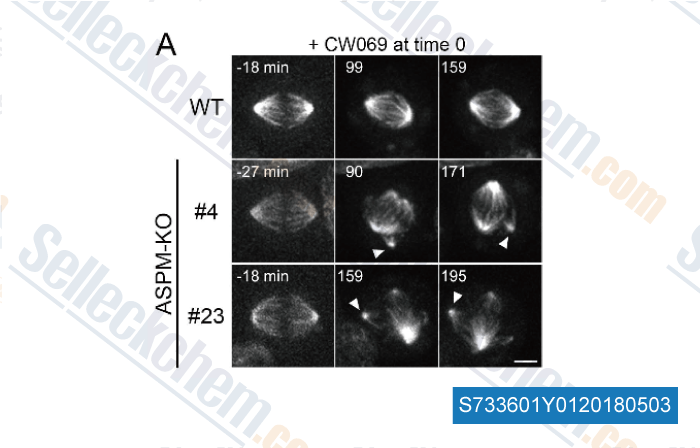|
Toll Free: (877) 796-6397 -- USA and Canada only -- |
Fax: +1-832-582-8590 Orders: +1-832-582-8158 |
Tech Support: +1-832-582-8158 Ext:3 Please provide your Order Number in the email. |
Technical Data
| Formula | C23H21IN2O3 |
||||||||||
| Molecular Weight | 500.33 | CAS No. | 1594094-64-0 | ||||||||
| Solubility (25°C)* | In vitro | DMSO | 100 mg/mL (199.86 mM) | ||||||||
| Ethanol | 4 mg/mL (7.99 mM) | ||||||||||
| Water | Insoluble | ||||||||||
| In vivo (Add solvents to the product individually and in order) |
|
||||||||||
|
* <1 mg/ml means slightly soluble or insoluble. * Please note that Selleck tests the solubility of all compounds in-house, and the actual solubility may differ slightly from published values. This is normal and is due to slight batch-to-batch variations. * Room temperature shipping (Stability testing shows this product can be shipped without any cooling measures.) |
|||||||||||
Preparing Stock Solutions
Biological Activity
| Description | CW069 is an allosteric, and selective inhibitor of microtubule motor protein HSET with IC50 of 75 μM, significant selectivity over KSP. | ||
|---|---|---|---|
| Targets |
|
||
| In vitro | CW069 increases multipolar spindles in N1E-115 cells with supernumerary centrosomes without altering bipolar spindle morphology in normal human dermal fibroblast cells. CW069 inhibits growth in cancer N1E-115 cells with IC50 of 10 μM, but not in NHDF or primary human bone marrow cells. [1] | ||
| Features | Allosteric, HSET-selective inhibitor. |
Protocol (from reference)
| Kinase Assay:[1] |
|
|---|---|
| Cell Assay:[1] |
|
Customer Product Validation

-
Data from [Data independently produced by , , J Cell Sci, 2017, 130(21):3676-3684]
Selleck's CW069 has been cited by 8 publications
| Molecular landscape and functional characterization of centrosome amplification in ovarian cancer [ Nat Commun, 2023, 14(1):6505] | PubMed: 37845213 |
| Molecular landscape and functional characterization of centrosome amplification in ovarian cancer [ Nat Commun, 2023, 14(1):6505] | PubMed: 37845213 |
| KIF24 depletion induces clustering of supernumerary centrosomes in PDAC cells [ Life Sci Alliance, 2022, 5(11)e202201470] | PubMed: 35803737 |
| Terminally differentiated osteoclasts organize centrosomes into large clusters for microtubule nucleation and bone resorption [ Mol Biol Cell, 2022, mbcE22030098] | PubMed: 35511803 |
| IFT proteins interact with HSET to promote supernumerary centrosome clustering in mitosis. [ EMBO Rep, 2020, 9:e49234] | PubMed: 32270908 |
| Unraveling mitotic protein networks by 3D multiplexed epitope drug screening [ Mol Syst Biol, 2018, 14(8):e8238] | PubMed: 30104419 |
| Centrosome Clustering Is a Tumor-selective Target for the Improvement of Radiotherapy in Breast Cancer Cells [Choe MH Anticancer Res, 2018, 38(6):3393-3400] | PubMed: 29848688 |
| Precocious Centriole Disengagement and Centrosome Fragmentation Induced by Mitotic Delay [ Nat Commun, 2017, 13;8:15803] | PubMed: 28607478 |
RETURN POLICY
Selleck Chemical’s Unconditional Return Policy ensures a smooth online shopping experience for our customers. If you are in any way unsatisfied with your purchase, you may return any item(s) within 7 days of receiving it. In the event of product quality issues, either protocol related or product related problems, you may return any item(s) within 365 days from the original purchase date. Please follow the instructions below when returning products.
SHIPPING AND STORAGE
Selleck products are transported at room temperature. If you receive the product at room temperature, please rest assured, the Selleck Quality Inspection Department has conducted experiments to verify that the normal temperature placement of one month will not affect the biological activity of powder products. After collecting, please store the product according to the requirements described in the datasheet. Most Selleck products are stable under the recommended conditions.
NOT FOR HUMAN, VETERINARY DIAGNOSTIC OR THERAPEUTIC USE.
